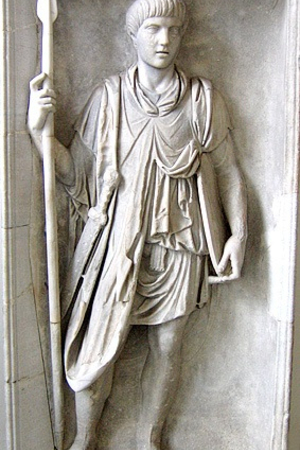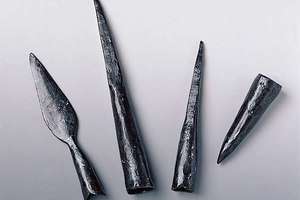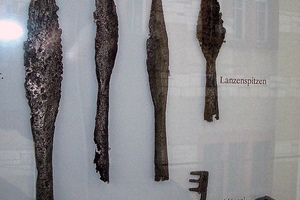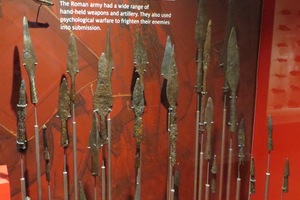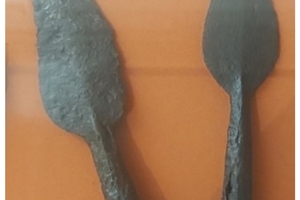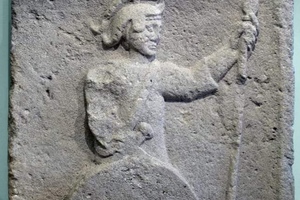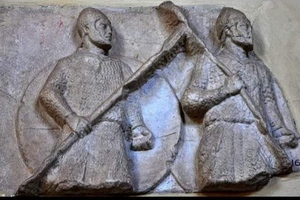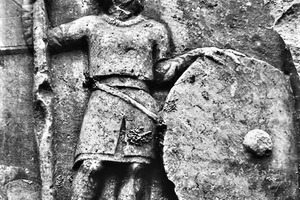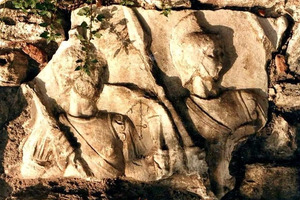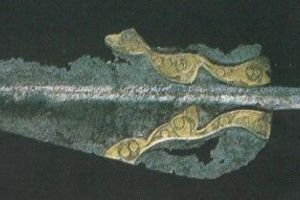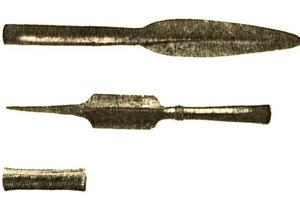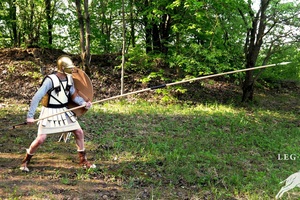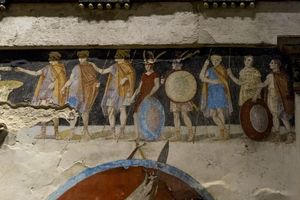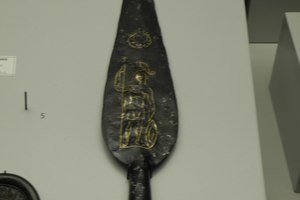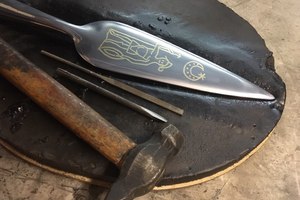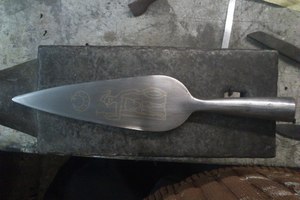Hasta
Gasta — a type of ancient spear with a sharp point on a long shaft, used for thrusting attacks. Typically, it consisted of a metal socket for embedding in the ground, a wooden shaft, and a metal tip. Spears could be adorned with gold, various patterns, and inlays.
There were several types of spears:
- Long thrusting spears used to engage the enemy from a long distance, allowing multiple rows to attack simultaneously. An example of this is the sarissa.
- This type also includes the hasta, used by auxiliaries.
- Medium-range spears designed for close combat, used by the first 2-3 ranks. An example of this is the gasta of auxiliaries.
- Throwing spears used for ranged combat, primarily used by velites.
- Pila, a type of heavy throwing spear capable of penetrating shields. These were exclusively used by legionaries.
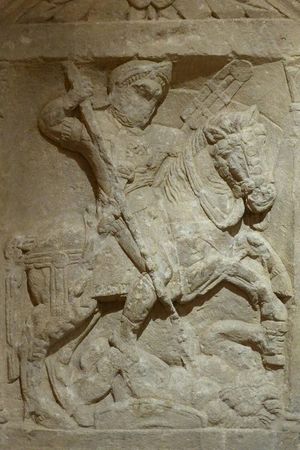 Tombstone of a horseman with a spear (Sex Flavius Genialis). Corinium Museum, Cirencester. CSIR I.7 No.137, 1st century CE.
Tombstone of a horseman with a spear (Sex Flavius Genialis). Corinium Museum, Cirencester. CSIR I.7 No.137, 1st century CE.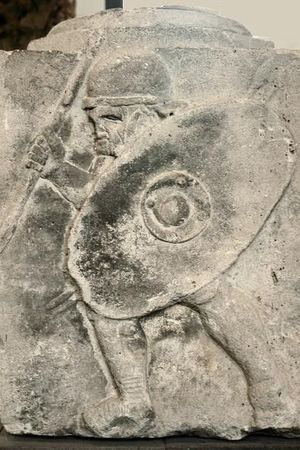 Depiction of a Roman auxiliary soldier with a spear and javelins. Bas-relief from the pedestal of one of the columns that adorned the courtyard in front of the headquarters building complex (praetorium and principia) of the citadel of the ancient Roman city Mogontiacum (modern Mainz, Germany). "Landesmuseum," Mainz, Germany. Second half of the 1st century CE.
Depiction of a Roman auxiliary soldier with a spear and javelins. Bas-relief from the pedestal of one of the columns that adorned the courtyard in front of the headquarters building complex (praetorium and principia) of the citadel of the ancient Roman city Mogontiacum (modern Mainz, Germany). "Landesmuseum," Mainz, Germany. Second half of the 1st century CE.Roman spears
Roman poet Ennius in the 3rd century BCE mentions the gasta as a throwing weapon. The Roman combat unit known as hastati derived its name from the gasta, although the triarii spear was also referred to as "hasta." During the time of Polybius, the hastati were already armed with pilum. Additionally, the term "gastus" (hasta velitaris) refers to the javelin used by a type of Roman skirmishers called velites. Historians speculate that initially, the Romans armed themselves with long spears for close combat, which were likely the classical gasta, and later began using lighter variations of spears, particularly for throwing (such as pilum and javelins).
It is worth noting the symbolism associated with spears among the Romans. It was the favored weapon of the god of war, Mars. As a ritual for declaring war, the fetiales (an ancient Roman priestly college) would throw a blood-stained gasta into enemy territory. The gasta could also be a special reward. A spear without a tip ("hasta pura" - literally "pure gasta") was awarded as a combat honor to primipilus (veteran centurions) upon completing their service during the Republic. There was also the "celibaris hasta" - a spear traditionally used to cut the hair of a bride. Some believe that a special gasta was used to end the lives of gladiators. When trading, a spear stuck into the ground announced the start of transactions ("subhastationes"), and a gasta would typically be present before the court of centumviri ("hasta centumviralis").
In the Roman Empire of the 1st and 2nd centuries CE, spears were primarily used by infantry and cavalry auxiliaries, as well as gladiators known as hoplomachus. Gastae were not thrown but mainly used for close combat. Another widely used type of spear was the pilum, which legionaries used for long-range combat.
In the early 3rd century CE, gasta once again became the main weapon of heavy infantry. According to iconography, the length of the spear slightly exceeded human height, and archaeological finds indicate a diamond-shaped tip.
Spears among the Celts
There is plenty of evidence of active spear usage among Celts. Diodorus writes about spearheads that are "a cubit in length" (approximately 45 cm) or even longer. It should be noted that impressive-sized spearheads are found in all periods of the La Tène culture. One enormous specimen discovered at the La Tène settlement measures 65 cm. Archaeologists frequently find spear and javelin heads in military burials. In La Tène, three complete sets of spears were also found, indicating their likely use as melee weapons rather than javelins (both spearheads and shafts, measuring 2.5 meters, were discovered). The spearheads came in various shapes, including slender, wide, leaf-shaped, with or without edges, and with different curvatures.
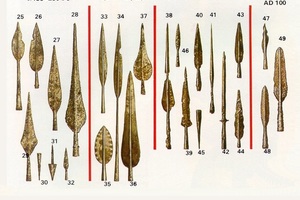 25-29 Spearheads. 30,31 - Sockets. 32 - Javelin tip. 25, 26, 27, 29, 37, 39 - Finds from France (Marne area, St Germain Museum). 28 - Northern Italy. 33-36 - Spearheads from La Tene, Neuchatel Museum. 38-46 - Spearheads from Alesia, central France (Marne area, St Germain Museum). 47 - Javelin from southern Britain. 48,49 - Spears from Camelon, Scotland.
25-29 Spearheads. 30,31 - Sockets. 32 - Javelin tip. 25, 26, 27, 29, 37, 39 - Finds from France (Marne area, St Germain Museum). 28 - Northern Italy. 33-36 - Spearheads from La Tene, Neuchatel Museum. 38-46 - Spearheads from Alesia, central France (Marne area, St Germain Museum). 47 - Javelin from southern Britain. 48,49 - Spears from Camelon, Scotland.Spears among the Greeks
The Greeks, famous for their hoplites and phalanxes, are the most well-known spear users. They relied on long spears, which allowed them to dominate the Mediterranean for a considerable period. An example of a Greek spear is the sarissa.
The sarissa (Ancient Greek: σάρισα, σάρισσα; Latin: sarissa) is a long thrusting spear or pike.
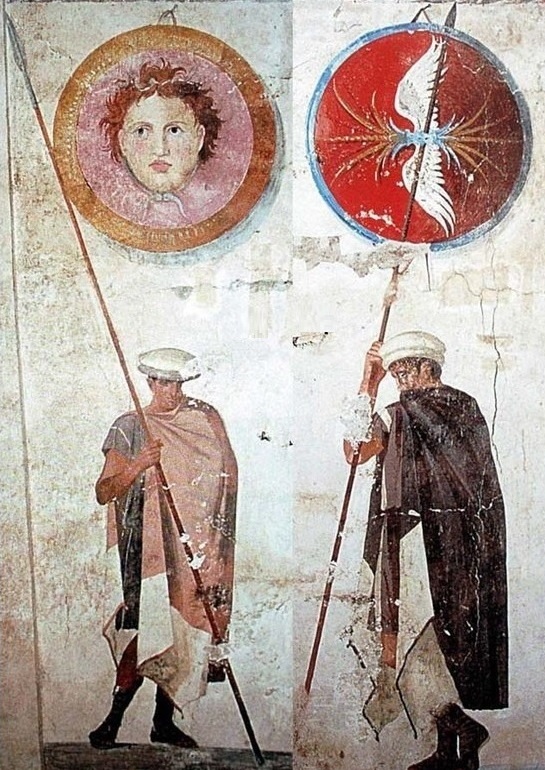 Depiction of sarissoforoi in the tomb of Agios Athanasios, late 4th century BCE.
Depiction of sarissoforoi in the tomb of Agios Athanasios, late 4th century BCE.
The sarissa gained its greatest fame during the reign of Philip in Macedonia. Historians believe that initially, this word referred to the spear shaft used by the Macedonians. Ancient Roman historians referred to various types of Macedonian spears as sarissas, not just the long pikes. For instance, Quintus Curtius Rufus called the sarissa a throwing spear, while Arrian used the term to describe a long melee weapon.
Polybius also mentions the sarissa: "The length of the pike, according to the original plan, was 16 cubits [1 cubit = 45 cm], but for practical use, it was reduced to 14 cubits, taking into account the space between the soldiers' hands and the heavier part of the pike [the end of the shaft opposite the tip], which was necessary for stability, totaling 4 cubits. It is evident that the pike must extend 10 cubits in front of each hoplite's body when he advances against the enemy, gripping the pike with both hands."
The ancient authors provide varying accounts of the sarissa's length. Aelian the Tactician and Polyenus describe it as 14-16 cubits (6.3-7.2 meters). However, other ancient historians mention its length as 10-12 cubits (4.5-5.4 meters). This discrepancy can be explained by the fact that the length of the sarissa could vary depending on the position of the soldier in the phalanx: the front ranks might use shorter pikes than those behind them. All the aforementioned authors describe the sarissa of the 2nd century BCE. It should be noted that based on visual sources, the length of the sarissa during the time of Alexander the Great is estimated to be around 3.6 meters.
Polyenus describes the tactics employed during the campaigns against Macedonia by the Spartan commander Cleonymus and the Epirote king Pyrrhus in the 270s BCE:
"During the siege of Edessa, when a breach was made in the wall, the spear-bearers with their 16-cubit-long pikes advanced against the besiegers. Cleonymus deepened his phalanx and ordered the first rank not to use their weapons but to quickly seize the enemy pikes and hold them. The soldiers of the next rank were to immediately advance and engage the enemy. When the pikes were thus captured, the enemy attempted to retreat, but the soldiers of the second rank rushed forward and either captured or killed them. With this maneuver, Cleonymus rendered the long and formidable sarissa useless, becoming more of a burden than a dangerous weapon."
Plutarch also describes the battle between the Romans and the Macedonian army in 168 BCE:
"The Macedonians managed to thrust the points of their sarissas into the shields of the Romans, making themselves unreachable by their swords... The Romans tried to fend off the sarissas with their swords, or bend them down with their shields, or push them aside, seizing them with their bare hands, but the Macedonians, gripping their spears even tighter, pierced through the attackers, and neither shields nor armor could protect against the blows of the sarissa."
The shaft of the sarissa was primarily made of cornel wood. The Archaeological Museum of Thessaloniki houses composite spear parts from the royal tomb at Vergina. It is believed that these are metallic components of a composite xyston, although there is an opinion that they are parts of a sarissa, and the validity of this view would simplify theories about the strength, ease of use, and transportation of this spear. The discovery includes a leaf-shaped head, a socket, and a central reinforcing ferrule. The diameter of the shaft in this find is 3.2 cm, and the total weight of the pike is approximately 6.8 kg.
Reenactment
Spear users were present in almost all ancient civilizations. The spear would be an excellent weapon for Greeks, Romans, Celts, and Germans. In Roman reenactments, it would be suitable for use by auxiliaries and hoplomachus gladiators.
Related topics
Pilum, Hoplite, Legion, Auxiliaries, Primipilus, Gladiator, Hoplomachus
Literature
- Connolly P. Roman Army in 160 BC / / Greece and Rome. Encyclopedia of Military History. Greece and Rome at War, Moscow: EKSMO-Press, 2001. SBN 5-04-005183-2.
- Neihardt, A. A. Legends and legends of ancient Rome
- A. Plyushar. Encyclopedic lexicon, volume 9.-Printing house of A. Plyushar; St. Petersburg.
- Gasta // Encyclopedia of Brockhaus and Efron : in 86 volumes (82 volumes and 4 additions). - St. Petersburg, 1890-1907
